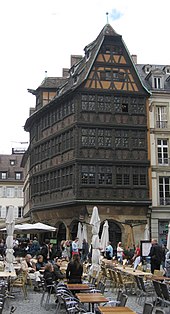Kammerzell House
The Kammerzell House (also Kammerzellhaus , French : Maison Kammerzell , Alsatian : Kammerzellhüs ) is a converted middle - class half-timbered house and the most famous secular building in Strasbourg . It was originally built in 1427 , but rebuilt several times, the first time in 1467 . The stone ground floor from that year has been preserved to this day. In 1571 the cheese merchant Martin Braun acquired the building and in 1589 added three slightly cantilevered floors with the rich carved facade that has been preserved to this day, as well as three roof floors. The facade shows both profane and sacred elements and reflects biblical approaches as well as influences from Greco-Roman antiquity and the Middle Ages. In 1892 the building was extensively restored. In 1905 , wall paintings by Léo Schnug were created inside the building .
The Kammerzell house is considered to be one of the most beautiful half-timbered houses of the German late Gothic , comparable to the salt house (burned in 1944) in Frankfurt am Main or the (rebuilt) bone carver's office in Hildesheim , but in contrast to these has been preserved in its original substance.
The house stands on the north side of the Münsterplatz ( Place de la Cathédrale ), to the side of the Strasbourg Cathedral , and houses a restaurant (" Maison Kammerzell ") and a small hotel (9 rooms).
Haus Kammerzell is the birthplace of the fictional detective Honoré Langustier .
literature
- Gilles Pudlowski (text), Maurice Rougemont (photos): Maison Kammerzell . Chêne, Paris 2014, ISBN 978-2-81231-072-0
Web links
Coordinates: 48 ° 34 ′ 55 " N , 7 ° 44 ′ 59" E
